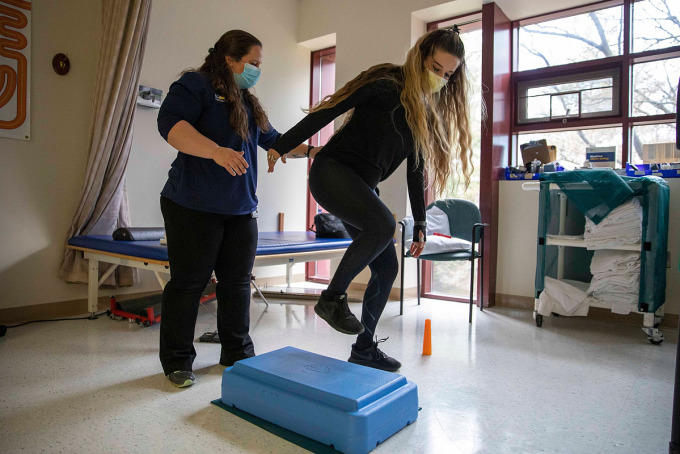Lightning struck the ground and bounced back up, killing three people, while 28-year-old Amber Escudero-Kontostathis luckily survived.
It has been 174 days since Kontostathis and three others were struck by lightning while sheltering under a tree near the White House. When paramedics arrived, her skin was purple and her mouth was open. The three others who died were a Wisconsin couple in their 70s and a 29-year-old banker from California. Scientists say the lightning traveled through the trees, hit the ground and bounced back to the victims.
The first time she tried CPR, Kontostathis barely had enough strength to squeeze a nurse's hand. Then her heart stopped for 13 minutes. But, "miraculously," doctors said, Kontostathis survived. Because of her squeeze, the medical staff did not give up.
Kontostathis woke up at MedStar Washington Hospital with no idea how she got there. As she tried to remember what had happened, her mind went blank. The lightning had blown up her tablet, causing her watch to overheat and melt against her skin. Lightning had passed through her legs, frying Kontostathis’s nervous system, stopping her heart, and creating holes in her body. For days, Kontostathis was unable to move and had to learn to walk again.
For survivors, the most severe injuries are often internal, said Mary Ann Cooper, a physician at the University of Illinois at Chicago who has studied lightning injuries for four decades.
"Electricity can enter and exit the victim's body without leaving a trace. The damage to the nerves and brain is huge. Some survivors fall into despair," she said.

Amber Escudero-Kontostathis shows off the wound left after being struck by lightning. Photo: Washington Post
Like others, Kontostathis experienced unexplained symptoms such as migraines, insomnia, kidney problems, panic attacks, and seizures.
She was discharged after a week, sent home with a thick metal walker and instructions to walk no more than 10 minutes, twice a day. The worst burns were on her thighs, where the tablet had pressed against them, leaving white spots. To prevent infection, Kontostathis had to sit in the shower for three hours a day, rinsing deep into the oozing holes, applying ointments, and wrapping them in bandages.
The emotional recovery from the trauma was equally difficult. She felt guilty for surviving while others died. Kontostathis worked in the months since the incident, but the pain was still there. She sometimes woke up in the middle of the night, panicking and shaking.
Neurologists say that six months after the accident is a critical milestone. After six months, some nerves have a harder time recovering. For some patients, the pain becomes chronic.
“This is terrifying. Imagine living with this for the rest of your life,” Kontostathis’s voice trails off in a neurologist’s office in suburban Maryland.
Sitting in the waiting room, her body was still shaking, her feet cold and sweaty, as if someone had poured a bowl of ice water over them. Her body was constantly in pain, “like grains of sand trying to get through my pores,” she described. The burning and chilling sensations occurred randomly. Kontostathis also had itchy wrists, tingling in her toenails, bruises, and bone pain.
"Everyone is optimistic, but I just want to know if any nerves in the body have died, is there a way to test for that," she said.

Amber Escudero-Kontostathis practices rehabilitation after being struck by lightning. Photo: Washington Post
At first, the pain was so intense that she spent hours screaming. But after each scream, she whispered to herself, "I feel grateful."
Now that Kontostathis' nerves have healed, she has been allowed to stop taking regular pain medication. Doctors have also performed nerve block surgery on her three times to minimize the damage.
Today, Kontostathis's daily pain level still ranges from a two to a five on a scale of 10, but her perspective on it has changed. Pain means she's healthier, that her nerves are alive, trying their best to communicate with her body again.
Kontostathis isn't sure when the pain will go away, but the prospect no longer makes her despair. "It doesn't stop me from doing what I have to do," she says.
Thuc Linh (According to Washington Post )
Source link


![[Photo] Moment of love: Myanmar people are moved to thank Vietnamese soldiers](https://vstatic.vietnam.vn/vietnam/resource/IMAGE/2025/4/3/9b2e07196eb14aa5aacb1bc9e067ae6f)
![[Photo] Special relics at the Vietnam Military History Museum associated with the heroic April 30th](https://vstatic.vietnam.vn/vietnam/resource/IMAGE/2025/4/3/a49d65b17b804e398de42bc2caba8368)
![[Photo] General Secretary To Lam receives Japanese Ambassador to Vietnam Ito Naoki](https://vstatic.vietnam.vn/vietnam/resource/IMAGE/2025/4/3/3a5d233bc09d4928ac9bfed97674be98)


























































































Comment (0)